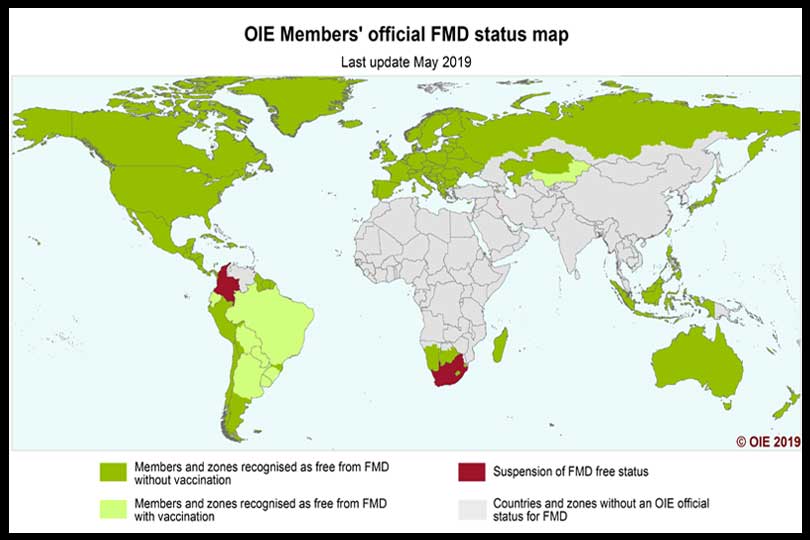By Jessica Domel
Multimedia Reporter
More than $197 billion and 1.5 million jobs—that’s what an outbreak of Foot-and-Mouth Disease (FMD) is estimated to cost U.S. agriculture over a decade if it is once again found in the United States.
The National Pork Producers Council (NPPC), National Milk Producers Federation (NMPF), National Corn Growers Association (NCGA) and Iowa State University urge the U.S. Department of Agriculture (USDA) to take action to ensure if there is another outbreak, there’s enough FMD vaccine in the continental U.S. to curb the disease’s spread.
“FMD is the most important animal disease in the world. It’s extremely contagious and can spread rapidly with devastating consequences through a naïve population. In the U.S., we don’t vaccinate, so all of our livestock are naïve to this virus and highly susceptible,” said Dr. James A. Roth, a professor in the Department of Veterinary Microbiology and Preventative Medicine at Iowa State University’s College of Veterinary Medicine.
FMD affects all cloven-hoofed animals like cattle, pigs, sheep, goats, deer, elk and other wildlife.
It’s present in 96 countries across the globe.
“It’s out there, and it’s prevalent. We’re under a constant threat that it might get into the U.S. and spread rapidly. The U.S. has had nine outbreaks of Foot and Mouth Disease,” Roth said.
The last U.S. outbreak was in 1929.
“The regulatory officials would stop all animal movement in that area and kill all the infected herds and neighboring herds to stop the virus. And that worked nine times quite well,” Roth said.
But things have changed since then.
Herds are larger and livestock are moved more.
“It isn’t feasible to stamp them out to stop the virus from replicating. And if you could stamp them out, practice disposal would be a huge problem,” Roth said. “The other way to stop the virus from replicating is to vaccinate the animals quickly, and the immune system will shut down that virus.”
It is estimated there are a million pigs and 400,000 to half-a-million cattle being moved every day in the U.S.
Seeing a potential threat, the agricultural organizations called for the expedient use of mandatory funding from the 2018 Farm Bill to purchase the amount of FMD vaccines required to effectively contain and eradicate an FMD outbreak.
They say USDA currently does not have access to enough vaccine for a widespread FMD outbreak, and it would take several weeks to make more.
“There’s a real possibility that by the time we detect a virus, it may already have moved extensively. It’s very difficult to stop movement in our modern animal agriculture,” Roth said. “Meat and milk production are just in time commodities. If we stop movement, and don’t keep the packing plants and dairy plants going, grocery stores would run out of meat and milk.”
There are two economic impacts from FMD, according to Roth. One is lost exports.
“Any country that has FMD, other countries won’t import their meat because of the danger of bringing in the virus,” Roth said.
The second economic impact would be the infection and loss of animals.
“If we get an outbreak that goes uncontrolled, we probably would have to stop stamping out because there would be so many affected animals,” Roth said.
Although a vaccine wouldn’t stop the closing of markets due to FMD, it could help the U.S. recover quicker, regain the lost markets and prevent tens of millions of animals from becoming sick.
“Vaccine is essential, and it needs to be rapidly essential,” Roth said. “Basically, for beef, if we get it and we have it for 10 years and without vaccine, there’s a likely chance that it may be 10 years before we can get rid of it. That could be $128 million impact for pork and beef and $69 billion for corn and soybeans, because there’d be less demand for corn and soybeans.”
There are seven different FMD serotypes and 65 different subtypes, which makes stockpiling a vaccine more difficult.
“The World Reference Laboratory says you need 23 different vaccines to cover all of those potential subtypes of virus because you don’t know which one you’re going to get. So, we need to stockpile multiple different vaccines to be sure we have the one that we may need,” Roth said.
USDA has started the process of developing an FMD vaccine bank.
They’ve published a sources-sought notice for potential vendors for the bank.
“We are extremely anxious to start building that robust vaccine bank that will help protect animal agriculture throughout the United States,” Liz Wagstrom, chief veterinarian at the National Pork Producers Council, said.


The NCBA is not worried they are the ones pushing all the imported into the U.S. They are against Country of Origin Labeling for Beef, I think the commingling of undifferentiated meat from foreign countries could be just what FM needs to get started here in the U.S. I think every cattle U.S producer should join R Calf which is the only group fighting for COOL. The NCBA is working for the multinational packers.